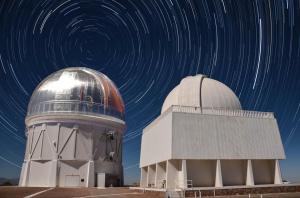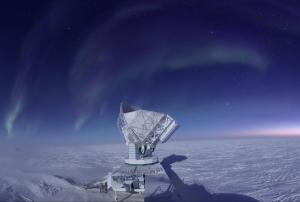Astronomers reveal new map of dark matter, mass in universe
University of Hawaiʻi at MānoaFor decades, cosmologists have mapped the distribution of mass in the universe, both visible material and the mysterious dark matter, in an effort to improve our understanding of these fundamental building blocks. Astronomer Eric Baxter from the University of Hawaiʻi Institute for Astronomy co-authored new research that traces the mass distribution in the universe in three dimensions. The updated analysis was published in Physical Review D.
Baxter and his University of Chicago collaborators, Chihway Chang and Yuuki Omori, compiled data using two different sky surveying methods.
This new analysis shows that there is six times as much dark matter in the universe compared to matter that is visible - a finding that was already well-known. However the team also found that the matter is not as clumpy as previously expected when compared to the current best model of the universe.
The researchers claim the findings could add to a growing body of evidence that there may be something missing from the existing standard model of the universe.
“It seems like there are slightly less fluctuations in the current universe than we would predict, assuming our standard cosmological model anchored to the early universe,” said Baxter. “The high precision and robustness to sources of bias of the new results present a particularly compelling case that we may be starting to uncover holes in our standard cosmological model.”
Using the latest large sky surveys
The team utilized the Dark Energy Survey (DES), an astronomical survey designed to constrain the properties of dark energy. DES uses visible light to map the distribution of galaxies.
Data was also collected using the South Pole Telescope (SPT), which can map the matter beyond the reach of galaxy surveys like DES. SPT operates at microwave frequencies and maps the relic radiation from the Big Bang known as Cosmic Microwave Background (CMB).
Combining these two distinct methods of looking at the sky not only increases the volume of the universe that can be probed, it also reduces the chance that the results are thrown off by an error or bias in one of the forms of measurement.
“It functions like a cross-check, so it becomes a much more robust measurement than if you just used one or the other,” said Chang, an astrophysicist at the University of Chicago.
Baxter, Chang and Omori, together with an international team of more than 150 collaborators from DES and SPT, combined data from three years of observations by DES with the SPT SZ survey, which ran from 2008–2011. The data was used to obtain new and high-precision constraints on the matter distribution across a wide range of cosmic history.
Next steps
Determining whether hints of problems in the standard cosmological model are real or just chance fluctuations will require more data. DES has three years of data that are waiting to be analyzed, and SPT is performing a new survey of the CMB with dramatically improved sensitivity. A third telescope, the Atacama Cosmology Telescope, is also currently undertaking a new high-sensitivity survey of the CMB. By combining these new and improved data sets, researchers expect to obtain dramatically tighter constraints on possible departures from the standard cosmological model in the near future.


